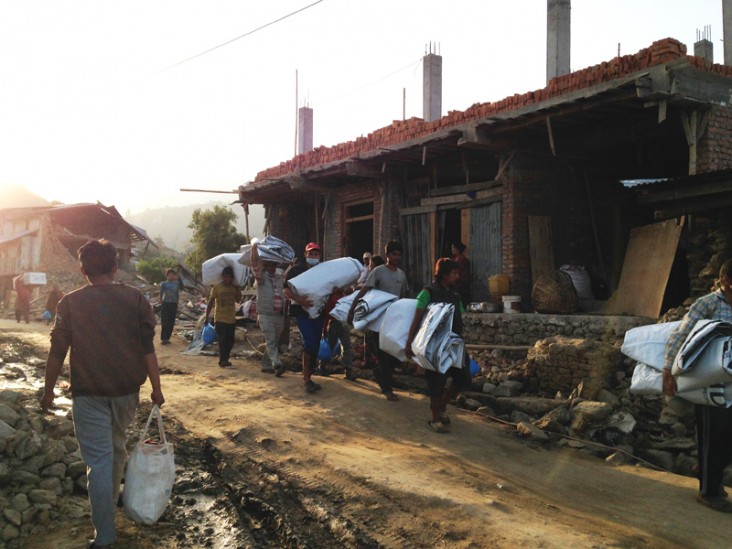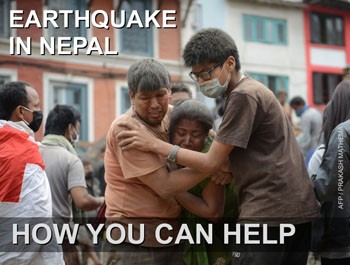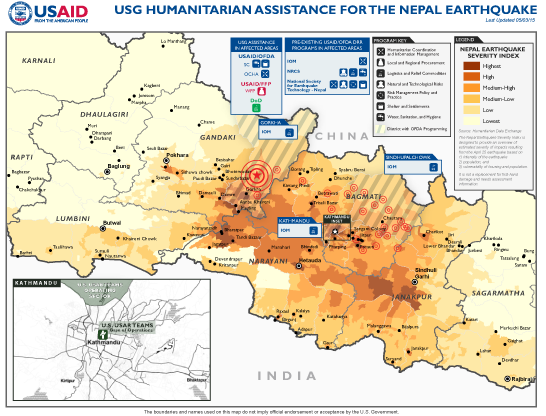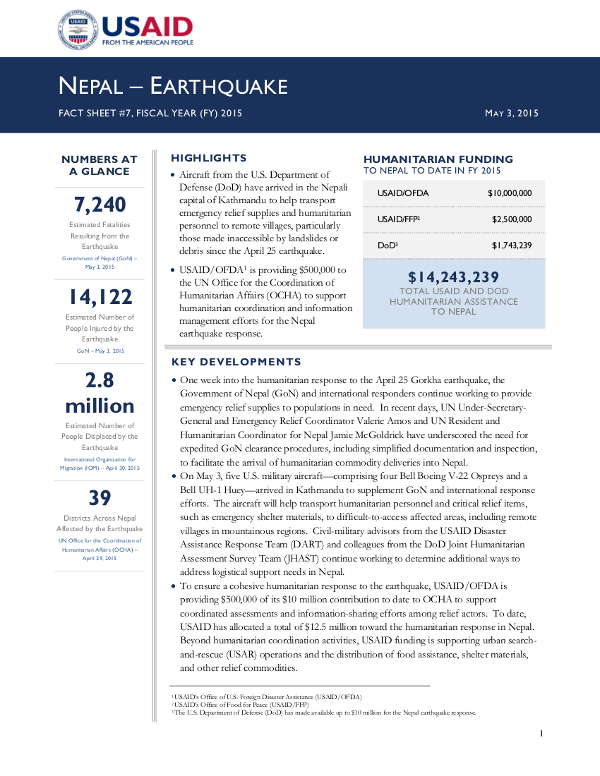Speeches Shim
May 3, 2015
Highlights
Aircraft from the U.S. Department of Defense (DoD) have arrived in the Nepali capital of Kathmandu to help transport emergency relief supplies and humanitarian personnel to remote villages, particularly those made inaccessible by landslides or debris since the April 25 earthquake.
USAID/OFDA is providing $500,000 to the UN Office for the Coordination of Humanitarian Affairs (OCHA) to support humanitarian coordination and information management efforts for the Nepal earthquake response.
Key Developments
Nepal Earthquake Map - May 3, 2015 ![]() (pdf - 1 MB)
(pdf - 1 MB)
Numbers At A Glance
7,240
14,122
2.8 million
39
Humanitarian Funding:
To Nepal To Date In FY2015:
| USAID/OFDA | $10,000,000 |
| USAID/FFP | $2,500,000 |
| DoD | $1,743,239 |
| TOTAL | $14,243,239 |
Nepal Earthquake Fact Sheet #7 - 05-03-2015 ![]() (pdf - 193k)
(pdf - 193k)
One week into the humanitarian response to the April 25 Gorkha earthquake, the Government of Nepal (GoN) and international responders continue working to provide emergency relief supplies to populations in need. In recent days, UN Under-Secretary-General and Emergency Relief Coordinator Valerie Amos and UN Resident and Humanitarian Coordinator for Nepal Jamie McGoldrick have underscored the need for expedited GoN clearance procedures, including simplified documentation and inspection, to facilitate the arrival of humanitarian commodity deliveries into Nepal.
On May 3, five U.S. military aircraft—comprising four Bell Boeing V-22 Ospreys and a Bell UH-1 Huey—arrived in Kathmandu to supplement GoN and international response efforts. The aircraft will help transport humanitarian personnel and critical relief items, such as emergency shelter materials, to difficult-to-access affected areas, including remote villages in mountainous regions. Civil-military advisors from the USAID Disaster Assistance Response Team (DART) and colleagues from the DoD Joint Humanitarian Assessment Survey Team (JHAST) continue working to determine additional ways to address logistical support needs in Nepal.
To ensure a cohesive humanitarian response to the earthquake, USAID/OFDA is providing $500,000 of its $10 million contribution to date to OCHA to support coordinated assessments and information-sharing efforts among relief actors. To date, USAID has allocated a total of $12.5 million toward the humanitarian response in Nepal. Beyond humanitarian coordination activities, USAID funding is supporting urban search-and-rescue (USAR) operations and the distribution of food assistance, shelter materials, and other relief commodities.
USAR AND LOGISTICS
As of May 3, the two USAID USAR teams remained on standby to support search operations in Rasuwa District, north of Kathmandu, as requested by the GoN. Road blockages continued to hinder access, however.
On May 2, the Logistics Cluster—the coordinating body for humanitarian logistical activities, comprising UN agencies, non-governmental organizations (NGOs) , and other stakeholders—reported that eight mobile storage units (MSUs) are fully operational in the humanitarian staging area at Kathmandu’s Tribhuvan International Airport. The cluster is also working to establish five additional logistics hubs across the country to support relief efforts in hard-to-reach areas.
The overland transport of emergency relief commodities from India is experiencing delays at the India–Nepal border due to customs and immigration procedures, according to relief agencies working in Nepal. In response, the UN is working with both governments to streamline the process and remedy delays.
Through the American Red Cross and the Asian Disaster Preparedness Center, USAID/OFDA has supported the Community Action for Disaster Response (CADRE) program in Nepal. In coordination with the Nepal Red Cross Society (NRCS), CADRE trains community-level teams on responding to multi-casualty incidents, such as earthquakes and landslides. Community members receive training on basic life support, community incident command systems, light search and rescue, and dead body management. Following the April 25 earthquake, NRCS deployed approximately 75 CADRE team members to earthquake-affected districts to provide assistance.
SHELTER AND DISPLACEMENT
In coordination with the UN Children’s Fund (UNICEF), staff from four local NGOs conducted an assessment of the 16 GoN-designated formal displacement sites in the Kathmandu Valley to identify incidences of orphaned or separated and unaccompanied children. While the assessment team identified a number of orphaned children sheltering with extended family members, the assessment had not found any separated or unaccompanied children at the sites as of April 29.
The most recent estimates from May 1 indicate that the April 25 earthquake destroyed nearly 161,000 houses and damaged an additional 143,600 residences, according to the GoN. In Gorkha and Sindhupalchowk districts, the earthquake destroyed an estimated 90 percent of homes, while more than 80 percent of homes in Dhading, Dolakha, Nuwakot, and Rasuwa districts were leveled. The number of destroyed homes countrywide may reach as high as 500,000, the GoN predicts. With the impending monsoon season due to begin in June, the UN has emphasized that shelter support remains an urgent need in affected communities.

To date, USAID/OFDA has consigned 700 rolls of heavy-duty plastic sheeting to IOM for onward distribution to affected households across Nepal. As of May 1, NGO the Agency for Technical Cooperation and Development (ACTED) had delivered 200 rolls to Kathmandu District’s Sankhu village and surrounding areas. The remaining 500 rolls are expected to reach households in Gorkha, Kathmandu, and Sindhupalchowk districts in the coming days through deliveries by Save the Children (SC).
HEALTH
On May 3, the UN World Health Organization (WHO) announced the establishment of a new field office in hard-hit Gorkha District in coordination with the GoN and other relief organizations. The office is scheduled to begin operation on May 4 and will support response actors, including the GoN district health office, offering both emergency and routine health care services in the district.
The Health Cluster reports that health teams have deployed to Gorkha and Sindhuli districts in response to reports of influenza and diarrheal cases. The cluster has also sent mobile clinics by helicopter to villages in the Langtang Valley and Rasuwa District. As of May 1, approximately 25,000 patients in Kathmandu Valley had received health services since the earthquake.
WASH
Through a recent assessment, Oxfam identified water, sanitation, and hygiene (WASH) concerns, including improper water storage and water treatment practices, in assessed villages of Gorkha District, the USAID DART reports. The extent of devastation in Gorkha has prompted the majority of the district’s earthquake-affected households to shelter outside with minimal supplies. Further, the difficulty of reaching affected areas is impeding response efforts, as navigating the hilly and steep terrain of Gorkha—as well as other earthquake-affected districts such as Dhading, Nuwakot, and Sindhupalchowk—requires hours of hiking by foot, according to Oxfam.
As of May 2, WASH Cluster member had distributed oral rehydration salts, water treatment tablets, and soap in eight earthquake-affected districts. The cluster aims to provide WASH services and items to an estimated 4.2 million people.
Prior to the earthquake and with USAID/OFDA support from previous FYs, NRCS had pre-positioned hygiene promotion kits, as well as emergency latrine construction materials, to facilitate a swift response in the event of a large-scale disaster. USAID/OFDA funding also allowed NRCS to install two emergency water treatment units in Bhaktapur District in FY 2013. NRCS recently relocated one unit to Sindhupalchowk—one of the most-affected districts to date—following a determination that a sufficient amount of safe drinking water is available in Bhaktapur.
FOOD SECURITY
The Food Security Cluster reports that food items, including noodles, biscuits, salt, and sugar, had reached 11 earthquake-affected districts as of May 1. Food assistance distributions were ongoing in seven districts—Bhaktapur, Dhading, Gorkha, Kathmandu, Lalitpur, Nuwakot, and Sindhulpachowk—as of May 2.
To date, USAID/FFP has provided WFP with $2.5 million for the purchase of 1,390 metric tons (MT) of rice to address the food needs of approximately 120,000 earthquake-affected people for one month. According to the Food Security Cluster, as many as 1.4 million people may require urgent food assistance following the April 25 earthquake.
CONTEXT
On April 25, a magnitude 7.8 earthquake struck central Nepal at a shallow depth of approximately 15 kilometers (km), according to the USGS. The epicenter of the earthquake was located approximately 77 km northwest of Kathmandu, the country’s capital city, and 73 km east of Pokhara, another major city in central Nepal.
The USG immediately issued a disaster declaration for Nepal due to the effects of the earthquake. Within hours of the seismic event, USAID/OFDA had activated a RMT in Washington, D.C., and deployed a DART—including USAR specialists—to support emergency response efforts in Nepal.
For nearly two decades, USAID/OFDA has supported disaster risk reduction (DRR) efforts in Nepal, including throughout Kathmandu Valley. USAID/OFDA funding has enabled the International Organization for Migration (IOM) to identify, prepare, and preserve more than 80 open spaces in Kathmandu Valley to ensure the sites are available for humanitarian purposes—such as distribution centers or warehouses—in the event of large-scale disasters. USAID/OFDA has also supported NRCS to pre-position critical emergency relief supplies in order to address the immediate needs of affected communities following a disaster.
Through the Kathmandu-based National Society for Earthquake Technology (NSET), USAID/OFDA is strengthening Nepal’s earthquake response capacity by institutionalizing DRR at the local and national levels in collaboration with the GoN, non-governmental organizations, schools, and local communities. With USAID/OFDA support, NSET is also promoting public-private partnerships for earthquake risk management and enhancing the capacity of municipal governments to develop and administer building code permits and control systems to better protect against seismic activity.
PUBLIC DONATION INFORMATION
The most effective way people can assist relief efforts is by making cash contributions to humanitarian organizations that are conducting relief operations. A list of humanitarian organizations that are accepting cash donations for disaster responses around the world can be found at www.interaction.org.
USAID encourages cash donations because they allow aid professionals to procure the exact items needed (often in the affected region); reduce the burden on scarce resources (such as transportation routes, staff time, and warehouse space); can be transferred very quickly and without transportation costs; support the economy of the disaster-stricken region; and ensure culturally, dietary, and environmentally appropriate assistance.
More information can be found at:
- The Center for International Disaster Information: www.cidi.org or +1.202.821.1999.
-
Information on relief activities of the humanitarian community can be found at www.reliefweb.int.




Comment
Make a general inquiry or suggest an improvement.